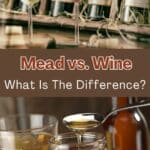Mead Vs Wine - 3 Key Differences You Need To Know
When it comes to mead vs wine, have you ever wondered what makes these ancient drinks so unique? Ever heard of the "drink of the gods" and wondered what makes it so special? Or why your favorite red wine tastes so different from that golden honey wine? Let’s explore!

Mead, often called honey wine, has been enjoyed for thousands of years. This ancient drink, made from fermenting honey, water, and yeast, is steeped in rich history and myths from various cultures, including the Vikings and the ancient Greeks. It’s no wonder that mead has been dubbed the "nectar of the gods."
On the other hand, wine, crafted from grapes, has its own long history and cultural significance, from the vineyards of ancient Greece to modern-day wineries in the United States. Both beverages have their unique charm and place in the world of fermented drinks.
Mead and wine are both delightful drinks, but they have distinct characteristics. We’ll look at three key differences between these ancient beverages: ingredients and production, flavor profiles, and historical significance.
By the end, you’ll know exactly what sets mead apart from wine! Whether you’re a fan of sweet mead, dry wines, or anything in between, understanding these differences will deepen your appreciation for these storied drinks. So, let's dive in and uncover the secrets behind mead and wine!

3 Key Differences of Mead vs Wine
Difference #1: Ingredients and Production Process
Mead Ingredients
Mead, often called "honey wine," has some basic ingredients: honey, water, and yeast. The primary ingredient is honey, which gives mead its sweet flavor. The type of honey used can greatly influence the taste, creating a spectrum of flavors from light and floral to rich and robust.
Sometimes, people add various fruits or spices to create different flavors, like apple juice or maple syrup. This addition can result in a wide variety of meads, each with its own unique twist, from sweet mead to spiced mead.
Wine Ingredients
Wine, especially grape-based wine, uses grapes as its primary ingredient. Red wines are made from red grapes, while white wines come from white grapes. The natural sugars in grapes play a big role in the wine's flavor.
The type of grape, whether it’s pinot noir or pinot grigio, along with the growing conditions, greatly affects the taste. Sometimes, other fruits and additional ingredients are added for more complex tastes, enhancing the overall flavor profile of the wine.
Production Process
The fermentation process is where mead and wine truly differ. In mead production, the mixture of honey and water ferments, turning natural sugars into alcohol. This honey-based beverage can vary widely depending on the type of honey and any additional flavors added. The fermentation process for mead is relatively simple but requires careful attention to achieve the right balance of sweetness and alcohol content.
Wine production starts with crushing grapes to release the grape juice. This juice ferments with the help of yeast, turning the fermentable sugar in the grapes into alcohol. The winemaking process involves several steps, including pressing, fermentation, aging, and bottling. Winemaking techniques include aging the wine in oak barrels to develop different flavors, adding complexity and depth to the final product. Both drinks undergo a brewing process that involves careful monitoring to achieve the desired final product, but the steps and ingredients used are quite distinct.
In summary, mead uses honey as its primary ingredient, while wine relies on grapes. The production process for each results in distinct characteristics that make these fermented beverages unique. Mead's flavor is heavily influenced by the type of honey and any additional ingredients, while wine's taste depends on the type of grape and winemaking techniques. This fundamental difference in ingredients and production is what gives each drink its own special place in the world of fermented beverages.

Difference #2: Flavor Profiles and Varieties
Mead Flavor Profiles
Mead, also known as honey wine, offers a wide range of different flavors. The type of honey used plays a big role in mead's flavor profile. For example, orange blossom honey might make a light, citrusy mead, while buckwheat honey could produce a darker, earthier flavor.
You can find sweet mead, dry meads, and everything in between. Additional ingredients like fruits and spices can make mead taste even more unique. For instance, adding apple juice or various fruits can create a fruitier mead, while spices like cinnamon or cloves can add a warm, spiced touch.
Traditional mead, which uses only honey, water, and yeast, has its own category but still offers many varieties. Each type of honey and additional ingredient gives mead its distinct characteristics, making each batch a new adventure in flavor.
Wine Flavor Profiles
Wine flavors come mainly from the type of grape used and the winemaking process. Red wines, made from red grapes, often have richer and deeper flavors.
These flavors can range from fruity, like in a pinot noir, to bold and tannic, like in a cabernet sauvignon. White wines, made from white grapes, are usually lighter and crisper. For example, pinot grigio has a fresh, citrusy flavor, while chardonnay can be buttery and oaky.
Wines can also have different flavors based on how they are aged, sometimes in oak barrels, which can add notes of vanilla or spice. The natural sugars in the grapes and any added fruits or spices can make the wine taste sweet or dry. Popular types like pinot noir and pinot grigio each have distinct flavor profiles, influenced by the grape variety and the winemaking techniques used.
Varieties
Both mead and wine come in various styles, offering a range of delightful drinks to explore. For mead, the main types include traditional mead, sweeter meads, and dry meads. There are also meads made with fruits, known as melomels, or with spices, known as metheglins. Mead can be still, carbonated, or sparkling, each offering a different drinking experience. The carbonation can add a refreshing fizz, similar to craft beer, while still mead highlights the pure flavors of the ingredients.
Wine also has many varieties, like red wine, white wine, and rosé. Each variety of wine grapes, including red grapes and white grapes, offers a unique flavor. Sparkling wines like champagne, dessert wines like port, and fortified wines like sherry provide even more diversity. Each type of wine has its own flavor profile and can be enjoyed in different settings, from casual dinners to special celebrations.
In summary, mead’s flavor depends on the type of honey and any additional ingredients, while wine’s flavor comes from the type of grape and winemaking techniques. Both mead and wine offer a wide array of flavors and varieties, making them exciting and versatile choices for any palate. Whether you prefer the honeyed notes of mead or the grape-based complexity of wine, there is always something new and delightful to discover.

Difference #3: Historical and Cultural Significance
Mead History
Mead is one of the oldest known alcoholic beverages. It dates back thousands of years to ancient cultures like those in Northern China and ancient Greece. Historical records and archeological findings show that people have been enjoying mead for a very long time.
Often called the "nectar of the gods," mead was a popular drink in many early civilizations. The ancient Greeks praised mead in their writings, while medieval Europeans, including the Vikings, loved this honey wine. They drank it in grand feasts and considered it a gift from the gods.
In Norse mythology, mead was believed to inspire poets and warriors, giving them strength and wisdom. The history of mead shows it was celebrated in various cultures and often linked to myths and legends, highlighting its importance and special place in ancient societies.
Wine History
Wine also boasts a long and storied history. The ancient Greeks and Romans were renowned for their grape wine. They enjoyed both red wines and white wines, which were integral to their social and religious life.
The Greeks often drank wine mixed with water during symposiums, where they discussed philosophy and politics. The Romans expanded the wine trade across their empire, making grape-based wine popular in many parts of Europe and beyond.
Over centuries, the art of winemaking evolved with new techniques and grape varieties, such as pinot noir and pinot grigio. The spread of wine to the United States and other regions continued to enhance its global significance. Today, wine remains a key part of many cultural and religious traditions, celebrated for its rich flavors and social value.
Cultural Impact
Both mead and wine hold a special place in history and culture. Mead was often seen as a drink of the gods and was used in celebrations and rituals. Kings and warriors would toast with mead to honor their victories and gods. Today, organizations like the American Mead Makers Association strive to keep this ancient tradition alive, celebrating the diverse and rich flavors of mead.
Wine, with its own category in the world of beverages, has been celebrated in epic poems and enjoyed in tasting rooms around the world. Its role in religious ceremonies, like Christian Communion, and in cultural events, like toasts at weddings, shows its deep-rooted importance.
Different cultures have their unique ways of making and enjoying these delightful drinks. For example, aging wine in oak barrels can add complex flavors, while the different types of honey used in mead production can create a wide variety of tastes. Both beverages continue to be a vital part of cultural heritage, enjoyed by people all over the world.
In summary, mead and wine both have rich histories and important cultural significance. Mead's history is linked to ancient times and legends, while wine has been an important part of many cultures and traditions. These delightful drinks have been cherished throughout history and continue to be celebrated today.

Conclusion
Mead and wine are both amazing fermented beverages with unique qualities.
- Ingredients and Production Process: Mead, or honey wine, uses honey as its primary ingredient, while wine is made from grapes. The fermentation process for mead involves honey, water, and yeast, while wine production focuses on fermenting grape juice.
- Flavor Profiles and Varieties: Mead's flavor depends on the type of honey and additional ingredients like fruits and spices. Wine's flavor comes from the type of grape used and winemaking techniques, resulting in varieties like red wines, white wines, and sparkling wines.
- Historical and Cultural Significance: Mead has a long history, dating back to ancient cultures and myths, and was considered the "nectar of the gods." Wine also has a rich history, celebrated by the ancient Greeks and Romans, and remains an important part of cultural and religious traditions.
Next time you enjoy a glass, whether it's sweet mead or pinot noir, you'll appreciate the distinct characteristics and rich histories of these delightful drinks!



